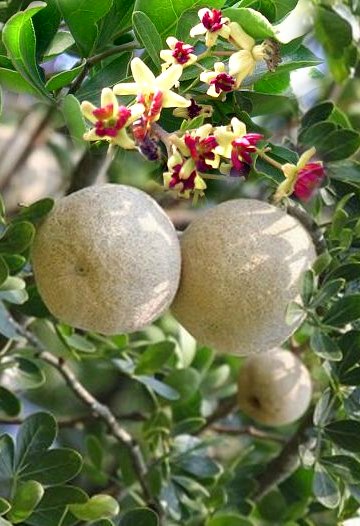
|
|
Wood Apple (Limonia acidissima).
Flowers and fruits.
|
Wood Apple - Limonia acidissima
Limonia acidissima (syns. Feronia limonia Swingle, F. elephantum
Correa, Schinus limonia L.) is the only species within the monotypic genus
Limonia, in the family Rutaceae. Common names for the species in English include wood-apple and elephant-apple.
A true multipurpose tree, it is both gathered from the wild and also cultivated for its edible fruit, plus its wide range of medicinal and other uses.
Limonia acidissima is a large tree growing to 9 metres (30 ft) tall, with rough, spiny bark.
The slow-growing tree is erect, with a few upward-reaching branches bending outward near the summit where they are subdivided into slender branchlets drooping at the tips. The bark is ridged, fissured and scaly and there are sharp spines :3/4 to 2 in (2-5 cm) long on some of the zigzag twigs.
The deciduous, alternate leaves, 3 to 5 in (7.5-12.5 cm) long, dark-green, leathery, often minutely toothed, blunt or notched at the apex, are dotted with oil glands and slightly lemon-scented when crushed. Dull-red or greenish flowers to 1/2 in (1.25 cm) wide are borne in small, loose, terminal or lateral panicles. They are usually bisexual.
The fruit is round to oval, 2 to 5 in (5-12.5 cm) wide, with a hard, woody, grayish-white, scurfy rind about 1/4 in (6 mm) thick. The pulp is brown, mealy, odorous, resinous, astringent, acid or sweetish, with numerous small, white seeds scattered through
it.
The fruit looks similar in appearance to the Bael fruit (Aegle marmelos) also known as the wood
apple. The fruit shape resembles an apple and the name wood apple is due to the fruit hard shell.
It contains considerable amount of protein, carbohydrate, iron, fat, calcium, Vit-B & C etc. 100 g of ripe fruit pulp contains up to 49 KCal.
The wood-apple is native and common in the wild in dry plains of India and Ceylon and cultivated along roads and edges of fields and occasionally in orchards. It is also frequently grown throughout Southeast Asia, in northern Malaya and on Penang Island. In India, the fruit was traditionally a "poor man's food" until processing techniques were developed in the mid-1950's.
The fruit is used to make a fruit juice with astringent properties and jams. Ripe fruit can be used as pickle (mashed with green chilly, sugar and salt only).
Another species of this fruits are considered auspicious to be offered to Shiva and Ganesha in pujas. A majority of Hindu temples will have a sacred tree within its compound and is known as the Sthala Vriksha.
The rind must be cracked with a hammer. The scooped-out pulp, though sticky, is eaten raw with or without sugar, or is blended with coconut milk and palm-sugar sirup and drunk as a beverage, or frozen as an ice cream. It is also used in chutneys and for making jelly and jam. The jelly is purple and much like that made from black currants.
A bottled nectar is made by diluting the pulp with water, passing through a pulper to remove seeds and fiber, further diluting, straining, and pasteurizing. A clear juice for blending with other fruit juices, has been obtained by clarifying the nectar with Pectinol R-10. Pulp sweetened with sirup of cane or palm sugar, has been canned and sterilized. The pulp can be freeze-dried for future use but it has not been satisfactorily dried by other methods.
The pulp represents 36% of the whole fruit. The pectin content of the pulp is 3 to 5% (16% yield on dry-weight basis). The seeds contain a bland, non-bitter, oil high in unsaturated fatty acids.
Medicinal Uses: The fruit is much used in India as a liver and cardiac tonic, and, when unripe, as an astringent means of halting diarrhea and dysentery and effective treatment for hiccough, sore throat and diseases of the gums. The pulp is poulticed onto bites and stings of venomous insects, as is the powdered rind.
Juice of young leaves is mixed with milk and sugar candy and given as a remedy for biliousness and intestinal troubles of children. The powdered gum, mixed with honey, is given to overcome dysentery and diarrhea in children.
Oil derived from the crushed leaves is applied on itch and the leaf decoction is given to children as an aid to digestion. Leaves, bark, roots and fruit pulp are all used against snakebite. The spines are crushed with those of other trees and an infusion taken as a remedy for menorrhagia. The bark is chewed with that of Barringtonia and applied on venomous wounds.
he trunk and branches exude a white, transparent gum especially following the rainy season. It is utilized as a substitute for, or adulterant of, gum arabic, and is also used in making artists' watercolors, ink, dyes and varnish. It consists of 35.5% arabinose and xylose, 42.7% d-galactose, and traces of rhamnose and glucuronic acid.
The wood is yellow-gray or whitish, hard, heavy, durable, and valued for construction, pattern-making, agricultural implements, rollers for mills, carving, rulers, and other products. It also serves as fuel.
Source:
https://en.wikipedia.org/wiki/Limonia_acidissima
https://hort.purdue.edu/newcrop/morton/wood-apple.html
